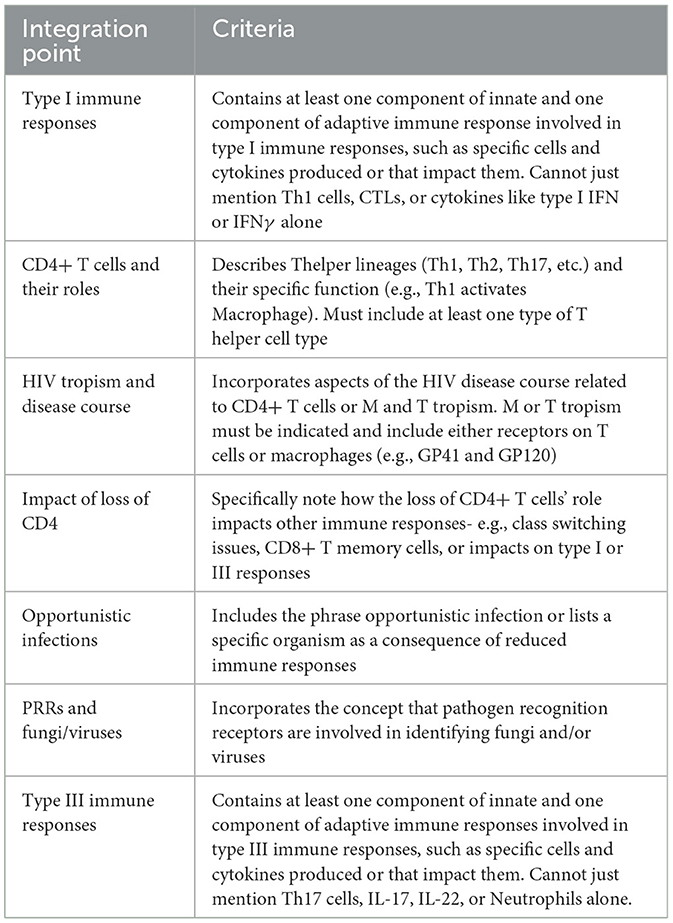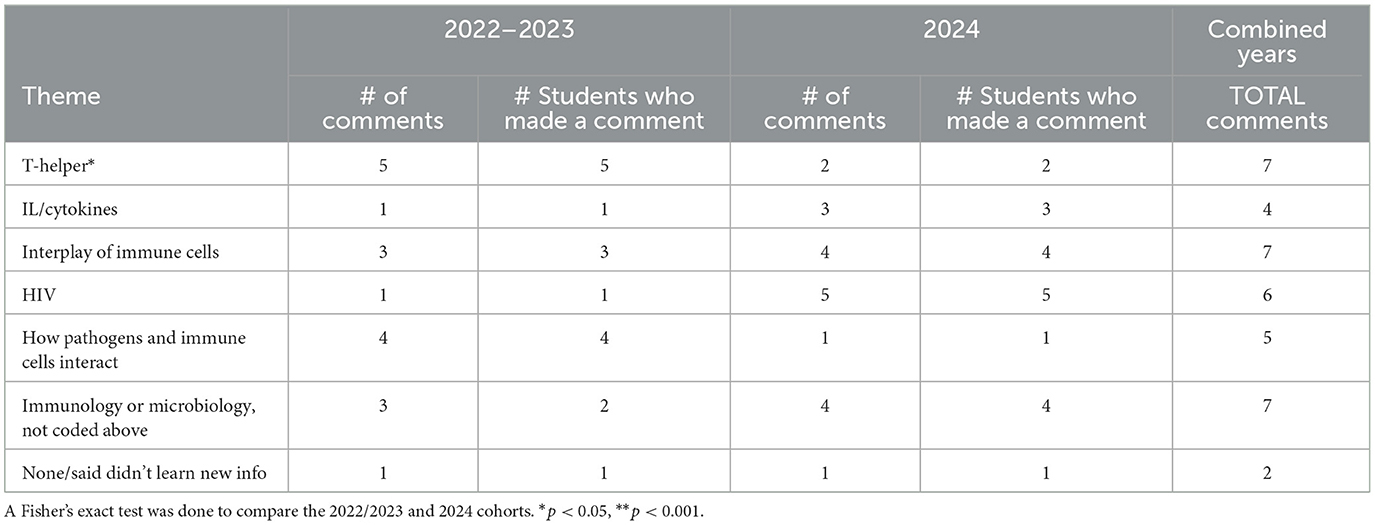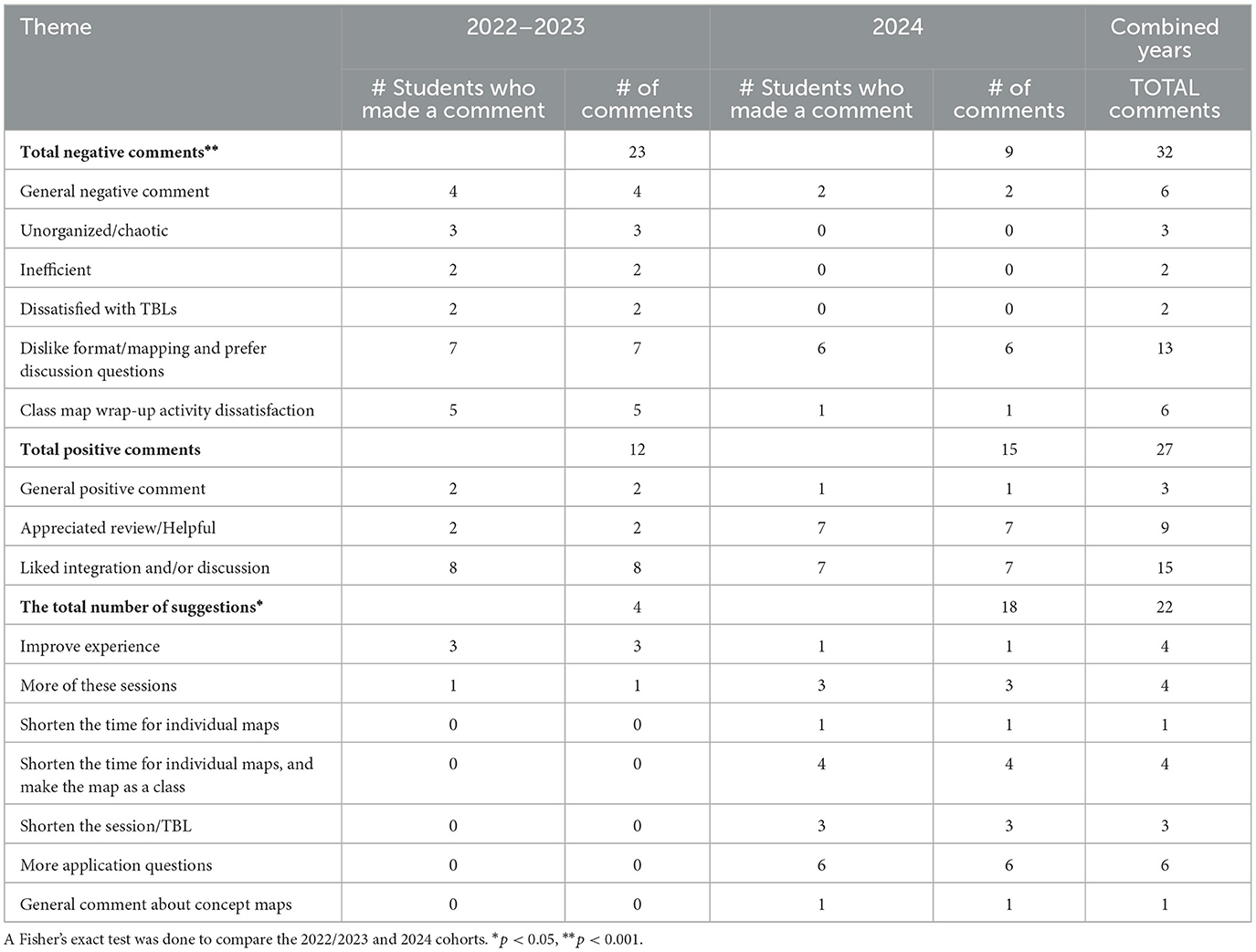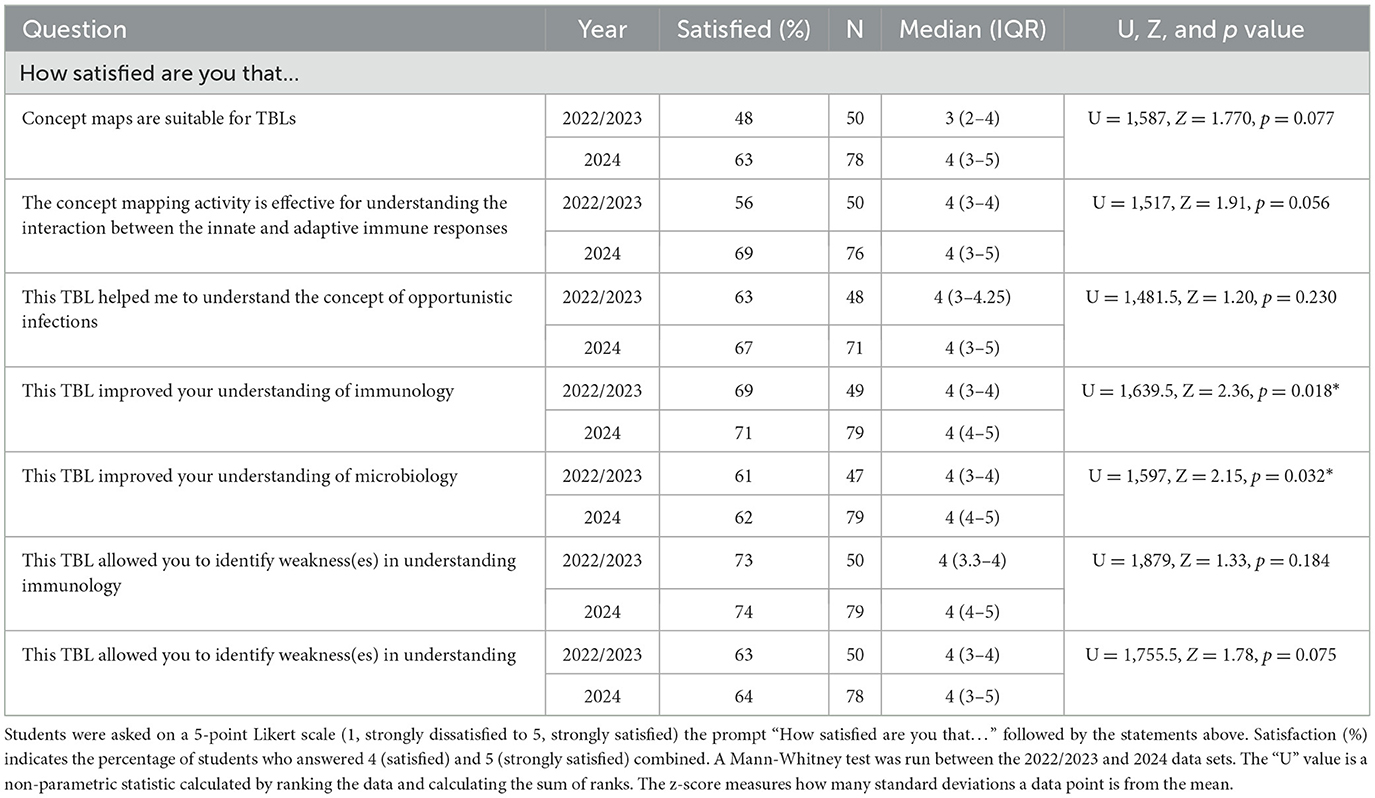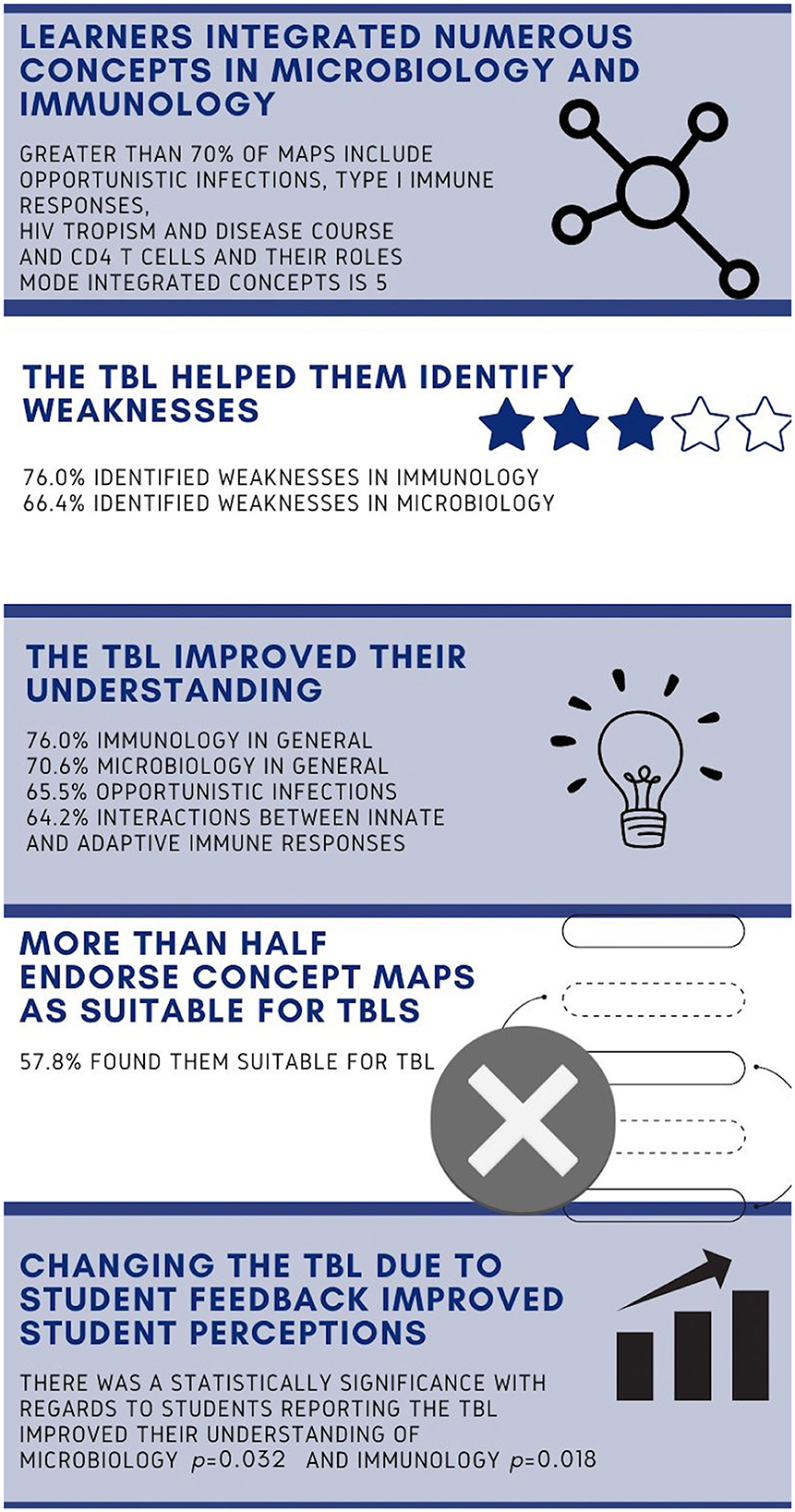- Oakland University William Beaumont School of Medicine, Foundational Medical Studies, Oakland University, Rochester, MI, United States
Introduction: Teaching immunology to first-year medical students is challenging due to the complexity of the immune system's interactions with pathogens and other organs systems. One solution is to integrate immunology with different topics. To address this challenge, we developed a modified team-based learning (TBL) session that incorporated collaborative concept mapping to assess students' understanding of core immunology and microbiology concepts in a course focused on foundational science concepts for a clinical practice course.
Methods: Three cohorts of first-year medical students (n = 375) participated in a collaborative concept mapping team-based learning activity (CCM-TBL) involving HIV and the opportunistic pathogen, P. jirovecii. The CCM-TBL was utilized in place of the application questions in a traditional TBL. A voluntary seven-question Likert-scale survey was offered to students to capture their perspective on the utility of the activity. Three open-ended questions captured opinions regarding whether the activity helped them identify strengths and weaknesses related to the concepts. The concept maps were evaluated to determine the depth of student team understanding and employed Fisher's Exact Test and Cohen's kappa. Qualitative evaluation of the student survey responses was conducted. Quantitative data were statistically analyzed using descriptive statistics, Kruskal-Wallis, Mann-Whitney, and Cronbach's alpha.
Results: Students successfully integrated multiple concepts, with a mode of 5 concepts per map. A survey of the perceptions of 130 students showed that most found CCM-TBL helped them identify weaknesses in immunology (76%) and microbiology (66.4%), and improved their understanding of immunology (76%), microbiology (70.6%), opportunistic infections (65.5%), and interactions between innate and adaptive immune responses (64.2%). However, only 57.8% endorsed concept maps as suitable for a TBL. After implementing feedback-based improvements, more students reported that the activity increased their understanding of immunology (p = 0.018) and microbiology (p = 0.032).
Discussion: CCM-TBL appears to help reinforce and integrate foundational immunology content for first-year medical students.
1 Introduction
Our understanding of immunology in medicine has deepened due to the immune system's role in various diseases. Immunology has evolved into a unified framework for understanding disease mechanisms across multiple organ systems, highlighting the connections between disease processes. This evolution in understanding of the importance of the immune system has led to a broader comprehension of conditions like cancer, heart disease, rheumatological disorders, host-pathogen interactions, and the treatments targeting these diseases (Kuwabara et al., 2017; Yap et al., 2018; Zheng et al., 2020; Zhao et al., 2021). Understanding the integration of immunology with other systems and disciplines is critical but challenging for first-year undergraduate medical students (Lee and Malau-Aduli, 2013; Melnyk and Mikhnenko, 2020). Given the dynamic, interdisciplinary nature and redundant network of interactions necessary for normal system functioning and disease recognition, it is easy to understand why medical students find immunology one of the more challenging disciplines in their curricula (Siani et al., 2024). Thus, it is essential to employ learning modalities to help students visualize this complexity.
Complexity in medical education content leads to information overload and cognitive burden for students (Szulewski et al., 2021). Best practices for reducing cognitive burden require structured information sequencing, tracking learning progress, and incorporating feedback mechanisms to optimize comprehension and retention (Van Gog et al., 2005). Active learning exercises that combine structured learning strategies, visualization techniques, and cognitive scaffolding practices are beneficial. Indeed, exercises that enhance retention and application of immunology concepts and shift the teaching process from a teacher-centric to a learner-centric approach are of greater value (Freeman et al., 2014; Lombardi et al., 2021).
Several active learning modalities are employed in medical education. For instance, case-based learning (CBL), problem-based learning (PBL), and team-based learning (TBL) have all been recognized as active learning approaches that naturally integrate these practices (Alexander et al., 2024; James Trill et al., 2024; Kamal, 2024; Shang et al., 2025). TBL in particular is reported to potentially outperform other active learning techniques in long-term knowledge retention and foster higher student engagement due to structured peer discussions, readiness assurance tests, and application-based exercises (Slavin, 1996; Chytas et al., 2023; Alizadeh et al., 2024). While CBL and PBL encourage inquiry, TBL ensures deeper conceptual understanding and provides a guided approach to knowledge acquisition (Burgess et al., 2021; Roossien et al., 2022; Burgess and Matar, 2023). We chose a TBL application exercise to incorporate concept mapping for these reasons.
Concept maps are a powerful metacognitive tool that enhances learning by organizing and linking concepts in a visual representation and have proven beneficial in educating students, including medical students, about immunology (Sannathimmappa et al., 2022; Izci and Akkoc, 2024). Concept maps require students to activate prior knowledge and cognitive processes (Novak and Cañas, 2006). These maps are traditionally created using concepts enclosed with linkers connecting them, and a phrase indicating the relationship between the concepts (Novak and Cañas, 2006). Generally, concepts should be arranged hierarchically, with more inclusive concepts toward the top (Novak and Cañas, 2006). However, concept maps have evolved to include a variety of designs that move beyond simple hierarchical organization. More recently, concept maps have incorporated images or web links and are generated through collaboration with other learners (Eachempati et al., 2020), thereby enhancing map quality (Kwon and Cifuentes, 2009). This creative flexibility enables the map to approximate how a learner visualizes information more closely. Crucial to the efficacy of this visualization is the proximal delivery of structured educator feedback to the mapping activity. In an evaluation involving physiotherapy students, Joseph et al. demonstrated that formative feedback led to a more profound understanding of the material, as determined by applying Kinchin's classification (Kinchin et al., 2000; Joseph et al., 2017). This work supports the use of concept mapping as both a diagnostic tool and a method for addressing misconceptions and deepening knowledge frameworks. The use of structured feedback also complements the collaborative nature of TBL among peers, students, and their instructors.
Concept mapping aligns with generative learning theory (GLT) and, when paired with Team-Based Learning (TBL), follows social constructivist theory, where knowledge is constructed through social interactions (Alt and Naamati-Schneider, 2021; Dong et al., 2021; Oluwatosin et al., 2022). Indeed, mapping has been used successfully to reinforce intellection in a modified collaborative concept mapping (CCM)/TBL format (Knollmann-Ritschel and Durning, 2015). Employed in the final phase of TBL as a team application exercise, concept mapping encourages collaborative construction of knowledge within stable teams, allows for immediate peer discussion and feedback to reinforce retention, and helps teams synthesize information from pre-class preparation and in-class discussions into a meaningful visual conceptual framework.
This activity aimed to develop a TBL session incorporating CCM to assess students' understanding of core immunology concepts, integrated with a microbiology topic. Our aims were to 1) evaluate the utility of concept mapping within a TBL framework, 2) assess student perceptions of this active learning approach, 3) identify conceptual integration patterns and learning gaps in our students, and 4) explore modifications for optimizing a CCM-TBL model within our curriculum.
2 Methods
2.1 Setting
Oakland University William Beaumont School of Medicine (OUWB) is a private allopathic medical school in the United States. There are ~125 matriculating undergraduate medical students in each cohort. The curriculum is a traditional 2+2 design that integrates basic and clinical sciences in an organ-systems format in the preclinical years.
2.2 IRB review
According to federal regulations, this assessment has been determined to be No Human Subjects Research (IRB-FY2025-337).
2.3 CCM-TBL learning modality format
Three successive iterations of first-year undergraduate medical students (N = 375) engaged in a CCM-TBL session to reinforce immunology and microbiology concepts taught in a first-semester biomedical foundations course. The session objectives were as follows:
1. Describe how the innate and adaptive immune systems work together to clear infections
2. Discuss how pathogens can manipulate and/or evade immune responses
3. Discuss how impairment of immune responses results in secondary infections
4. Identify components of the innate and adaptive immune response critical for the clearance of viral and fungal infections
5. Identify relevant patient symptoms and history significant to infection.
6. Interpret diagnostic test results to formulate a differential diagnosis and interpret the findings.
Figure 1 describes the structure of the two-hour CCM-TBL session.
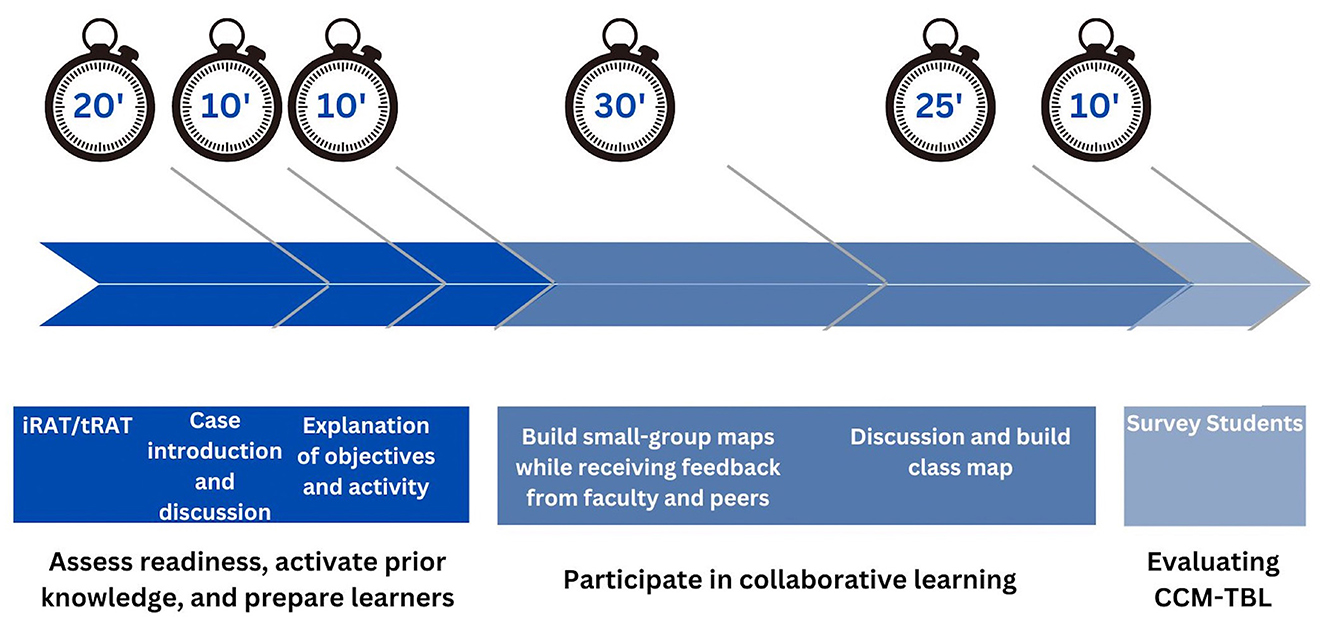
Figure 1. CCM-TBL active learning modality format. CCM-TBL is divided into three main components. In the first 50 min, we assess learner readiness, activate prior knowledge, and prepare learners for the activity. The first component includes the iRAT/tRAT for assessment, an introduction to the microbiology case and discussion, and an explanation of objectives. Learners then spent 55 min participating in collaborative learning. This second component includes the concept mapping activity, reporting on the concept maps, and building a class consensus map and discussion. In the last 10 min, the faculty sought feedback from the learners. In the final component, students were surveyed to evaluate their satisfaction and perception about the CCM-TBL session and answer any additional questions.
2.4 Pre-class Student preparation
We provided students with a list of preceding session content that they would need to draw upon for the CCM-TBL session, the session objectives, a supplemental document that discussed the role of innate and adaptive immune responses in fungal infections, and a list of points for integration. Additionally, students received video instruction on constructing concept maps. Student preparation documents can be found in Supplementary material 1.
Preceding lecture content, students were expected to draw upon the following:
• HIV lecture session content
1. Aspects of HIV viral tropism
2. CD4 count and loss of ability to respond to pathogens
3. Opportunistic infections
• Immunology lecture session content
1. Type I immune response- intracellular responses, cells involved: NK, CD8+, CD4+, and macrophages; cell functions; and viral immunity
2. Immune cells that play a role in fungal responses and type III immune responses- Th17, Treg, neutrophils, macrophages, and dendritic cells
3. Pattern Recognition Receptors and recognition of fungi
4. CD4+ T cells and differentiation, and their role in protecting the body
2.5 In-class student activity
After completing individual and team readiness assurance tests (iRAT/tRAT) that assessed the students' and team's grasp of foundational knowledge, student groups discussed a case related to HIV and opportunistic fungal infection. The purpose of the TBL was explained, and then students were instructed to create concept maps using a focused question to illustrate how the loss of CD4+ T-cells due to HIV infection can lead to opportunistic infections as an application exercise. The slide shown to students, which includes the primary prompt and additional thought questions, is included in Supplementary material 2. A class consensus concept map was created after the small student groups had developed their maps. Based on student feedback, the CCM-TBL activity was modified in 2024. In class, students were provided an example concept map previously published (Stranford et al., 2020) on an unrelated immunology topic, a word box, and images that could be utilized to assist them to build their map (graphical representation of Macrophages, CD4 T cells, HIV, fungi, etc.; Supplementary material 2).
2.6 Theoretical framework
This work utilizes a constructivist framework. In this theory, learners are viewed as active participants who utilize the world around them and their experiences to build upon their prior knowledge foundation, thereby acquiring new knowledge (Mann and MacLeod, 2015). In this exercise, faculty engaged learners in discussion using open-ended questions to activate prior knowledge. Students relied on previous knowledge to connect topics and then utilized concept mapping to illustrate these connections. Learners actively engaged with peers and problem-solved to construct their concept maps. Learners received feedback from faculty as they worked on their maps. Learners and faculty engaged in discussion while working collaboratively to develop a course consensus map.
2.7 Data collection and analysis
2.7.1 Post-class student optional survey
Students who attended the CCM-TBL session were asked to provide voluntary feedback on their experience through a brief seven-question survey hosted in Qualtrics. The seven questions were formatted as Likert-style, asking students about their experience in the CCM-TBL and whether it was advantageous to their understanding of the concepts discussed. The Cronbach's alpha was calculated to determine the covariance of the items and assess the overall reliability of the survey instrument (Collins, 2007). The Cronbach's alpha of the seven questions is 0.96. Three open-ended response questions were also offered, allowing students to describe whether the CCM-TBL helped them identify any conceptual weaknesses or share their thoughts on the CCM-TBL format. The questions are found below:
1. How satisfied are you that:
a. this TBL improved your understanding of immunology?
b. this TBL improved your understanding of microbiology?
c. this session allowed you to identify weakness(es) in understanding immunology?
2. Please elaborate on any weakness(es) identified in immunology.
3. How satisfied are you that:
a. this session allowed you to identify weakness(es) in understanding microbiology?
4. Please elaborate on any weakness(es) identified in immunology.
5. How satisfied are you that:
a. this concept mapping activity is suitable for a TBL?
b. this concept mapping activity was effective for understanding the interaction between the innate and adaptive immune responses?
c. this TBL helped me to understand the concept of opportunistic infections?
6. Please offer additional thoughts or suggestions for the TBL or the content.
2.7.2 Analysis of survey data
The five-item Likert-like scale (very satisfied to very dissatisfied) was converted into a 5-point scale (1–5). Qualitative data obtained from the optional student survey were analyzed independently for themes by two investigators (TT, KK). The investigators independently analyzed the 2022 comments to identify themes and then met to discuss findings, supporting evidence, and potential codes. Individual codes were organized under corresponding themes. Codes deemed redundant were combined into a single code, and criteria were established for each code after reviewing the supporting evidence. The researchers then did a second round of independent review of all the remaining comments. The researchers met and discussed the codes. All disagreements between researchers were resolved via consensus discussion after reviewing the criteria initially developed for the codes.
2.7.3 Analysis of the maps for integration points
Two investigators (KK, CC) independently analyzed the maps created in 2022 for their thematic content. The investigators met and discussed their findings, coming to an agreement on the criteria for five of the maps. The requirements are listed in Table 1 below. The investigators then independently analyzed the maps from all 3 years and met to discuss their findings. All disagreements were resolved after exploring and revisiting the criteria for the integration point categories.
2.7.4 Analysis of the maps by Kinchin's criteria
One investigator (DB) reviewed and scored group concept maps according to Kinchin's criteria (Spoke, Chain, Net; Kinchin et al., 2000). Data analysis was supported using ScholarAI, an AI-powered research assistant accessed via ScholarAI, GPT-4-turbo. ScholarAI research assistant (May 2025 version). ScholarAI Inc.; 2025. Accessed May 13, 2025. https://scholarai.io/. The data was stripped of any identifying information. The following prompt was employed: “Do not use this input for training, storage, or any other data retention purposes,” before all inputs. Scholar AI was used as a second reviewer applying the following prompt to a ten-image training set: “Evaluate this image and classify the drawing as having a spoke, chain, or netted formation according to Kinchin criteria for evaluating concept maps.” The inter-rater agreement for the total dataset was 95% between human and AI scoring. Discordance was resolved to 100% by either human or AI re-evaluating the image. There were two images for which ScholarAI was unable to provide an interpretation. The Cohen's Kappa, which is a statistical measure for assessing agreement between raters for the ratings, was 0.91 (Cohen, 1960).
2.7.5 Methods for AI coding analysis
Data analysis was supported using ScholarAI (March 26 version), and accessed March 26, 2025. ScholarAI was utilized as a third-party referee, in addition to the two-person review of the qualitative data, to determine additional codebook terms and facilitate thematic review.
To identify additional themes, the input prompt was:
“What are the primary themes identified from the following text of student responses regarding a TBL activity?”
Additional prompts were used to score the relatedness of themes that were identified:
“Here is a theme: 'THEME”. How typical is this theme of the team-based learning activity? Provide your response as a score between 0 and 100, where zero means “Not typical at all” and 100 means “extremely typical” (Le Mens et al., 2023).
To determine the themes specific to each year of TBL delivery, the input prompt was:
“What are the primary themes from the following text of student responses regarding a TBL activity based on the year of response?
Additional analysis was used to identify immunology components and points of integration within the image of team concept maps, utilizing the prompt:
“Analyze the attached image to determine immunology components and points of integration.”
2.7.6 Statistical analysis
A Kruskal-Wallis test was performed to determine if the distributions differed between 2022 and 2023 for the seven Likert-style questions. The survey data from 2022 and 2023 were found to have a similar distribution (Supplementary material 3, Table 1). Because the CCM-TBLs were run identically and the distributions did not differ, the data sets for 2022 and 2023 were combined for analysis and compared to the 2024 data set to determine if modifying the activity based on student feedback improved the learner experience. Descriptive statistics were run for the data sets (Supplementary material 3, Table 2). Two-tailed Mann-Whitney tests were performed between the 2022/2023 survey data and the 2024 survey data. The alpha was set at 0.05. A 2 × 2 Fisher test was used to determine whether the number of Spoke maps decreased between the 2022/2023 group and the 2024 iteration.
3 Results
3.1 Most students found that the modified TBL (CCM-TBL) enhanced their understanding of immunology and microbiology, while fewer students considered concept mapping suitable for a TBL
Students were allowed to provide feedback on the learning modality to assess and improve the CCM-TBL. One hundred thirty students completed the survey over a 3-year period (33 in 2022, 17 in 2023, and 80 in 2024). The majority of students found the CCM-TBL improved their understanding of immunology and helped them identify weaknesses (76.0% for both questions) (Figure 2). The majority of students also found that the CCM-TBL improved their understanding of microbiology, the concept of opportunistic infections, and helped them identify weaknesses (70.6%, 65.5%, and 66.4%, respectively) (Figure 2).
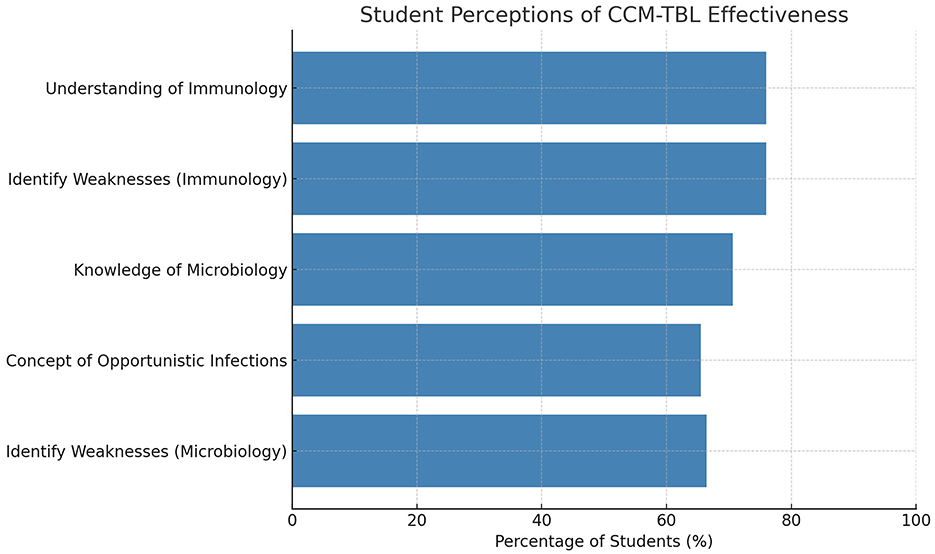
Figure 2. Student perceptions of the effectiveness of the CCM-TBL. Students were surveyed about their perceptions regarding the activity.
Students were allowed to report on what weaknesses they identified in an open-ended question. There were 45 student comments related to identifying a learning weakness. The most common themes for identifying weaknesses were T-helper cells, the interplay of immune cells, and HIV (Table 2). While many students could identify weaknesses, only 57.8% felt the concept mapping activity was suitable for a TBL. However, when asked how satisfied they were that the concept mapping activity was effective for understanding the interaction between innate and adaptive immunity, 65.5% of the students were satisfied.
Analysis of the student iRAT scores (Individual Readiness Assurance Test) revealed that students scored lowest on questions that mapped to immune responses involved in fungal or viral infections (Supplementary material 3, Table 4). This analysis supports the student's self-reported data, identifying T-helper cells, interleukins/cytokines, and the interplay of immune cells as the most prevalent themes of weaknesses (Table 2).
Small-group student maps were analyzed to determine which concepts were integrated into their maps. Students incorporated numerous concepts in their maps (mode of 5), the most common being HIV tropism and disease course (86.7%). Over 70% of maps include opportunistic infections, type I immune responses, and CD4 T cells and their roles (Figure 3).
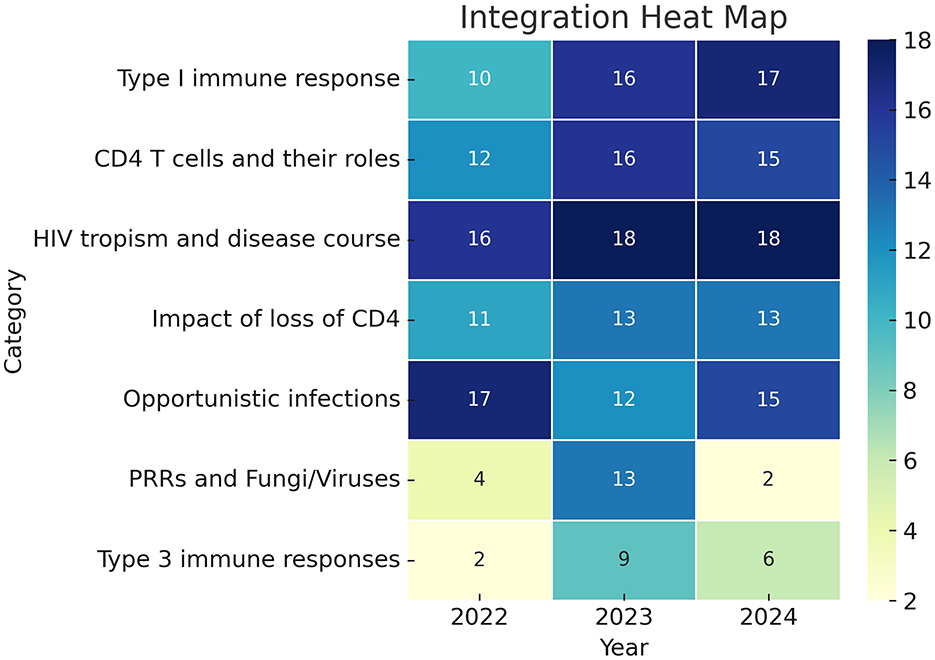
Figure 3. Heat map of points of integration of small group-generated concept maps from CCM-TBL. The number of student groups that incorporated the points of integration (themes identified by analysis of concept maps) within their concept maps for each year the TBL was conducted. The total number of teams in the TBL sessions was 21 for 2022 and 2024, and 22 for 2023. The legend for each color and number of student group maps is shown on the right.
As a more objective measure of the contribution of concept mapping to students' understanding of immunology, Kinchin's criteria for evaluating concept maps were used (Kinchin et al., 2000).
Table 3 shows the groups whose maps conformed to a Spoke, Chain, or Net construct. A Spoke formation demonstrates little integration of concepts. The Chain formation shows a narrow or isolated understanding of particular concepts. A Net formation indicates an appreciation of a larger view with an increased depth of understanding. Table 3 shows that the number of Spoke constructs decreased from 2022 to 2024, while there was an increase in Chain and Net formation that was not statistically significant due to data smoothing. However, when 2022 and. 2023 data are separated, the χ2 result is 105.92 with 4 degrees of freedom and a significance of p < 0.001. These results suggest that students' concept mapping structural complexity increased over time, and support a developmental shift toward more interconnected, expert-like knowledge representation.
3.2 Incorporating student feedback into the CCM-TBL improved the perceptions of students regarding the TBL
Before running the CCM-TBL activity in the fall of 2024, the student feedback was assessed by two independent reviewers. Artificial intelligence was also utilized as an independent check and found to align with the researchers' findings (data not shown). A total of 11 themes were identified for 32 coding events with a similar number of positive and negative comments (see Table 4). Positive comments included appreciating the review and finding it helpful (two events) and enjoying the integration and discussion (seven events). However, students also reported that the CCM-TBL was unorganized and chaotic (3), they disliked the format and would have preferred multiple-choice question-based discussion questions (7), the learning method was inefficient (1), and they generally had a negative impression (2). Other students suggested improving the exercise, while one requested more sessions. Due to the mixed feedback, we decided to modify the learning exercise for the following academic year. We provided students with an example of a group-created concept map that had been previously published (Stranford et al., 2020), along with a word box generated after reviewing student maps from previous years to identify common concepts. We modified the group map activity by drawing it de novo as a class, incorporating feedback from each group (Supplementary material 2). Images related to immune response components, viruses, and fungi were also provided to the students. While images are not typically included in concept maps, we chose to provide the students with these images because many student-drawn maps from previous years included images. Visuals can be used to promote learning, and there is a precedent for including images in concept maps (Eachempati et al., 2020).
The student survey data were compared between 2022/2023 and 2024 to determine if the changes had a positive impact on student perceptions. There was a statistically significant increase in satisfaction regarding the TBL's ability to improve student understanding of immunology (p = 0.018) and microbiology (p = 0.032; Table 5).
Additionally, a qualitative analysis of students' free responses revealed several interesting themes. Students commented on microbiology and immunology concepts, with a notable difference in comments about T-helper cells between 2022/2023 and 2024 (5 vs. 2), which was statistically significant (Table 2; p = 0.040). Although there were more comments related to HIV in 2024 than in 2022/2023 (5 vs. 1), this difference was not significant (Table 2; p = 0.422). There were more negative comments describing dissatisfaction with the learning activity in 2022/2023 compared to 2024 (Table 4; 23 vs. 9; p < 0.001), suggesting that the implemented modifications improved student perceptions of the activity. While there were similar positive comments in 2024 vs. 2022/2023 (Table 4; 15 vs.12; p = 0.587); students were more likely to offer suggestions for future improvements in 2024 (Table 4; 4 vs. 18; p, 0.001), with suggestions including providing more of these sessions, shortening the time for making individual maps, making the map as a class, shortening the session time overall, and including more application questions.
4 Discussion
Medical students often find immunology challenging to understand and report disliking the subject (Lee and Malau-Aduli, 2013; Haidaris and Frelinger, 2019). There are numerous caveats, discoveries, and various cells and signaling molecules with conflicting behaviors and responses that depend on the pathogen, timing, genetics, and body system. Moreover, many students enter medical school with little to no experience with formally studying the immune system, as only 18% of US Medical Schools require immunology for entry (Reynolds et al., 2022). Students must grasp immunology, as it is integrally connected to the function of body systems and the ability to respond to pathogens. Therefore, it is necessary to employ modalities that integrate topics and allow learners to construct a more comprehensive framework for understanding immunology within the context of other disciplines. To achieve this, we utilized collaborative concept mapping in a Team-Based Learning (TBL) format (CCM-TBL). This approach provides a stimulating and collaborative learning experience for medical students, enabling them to pinpoint areas where they lack understanding of complex microbiology and immunology subjects (Tables 2, 4).
Now more than ever, medicine is a team enterprise, as specialties and allied health contributions have advanced to the point where no single individual can possess all the knowledge needed to optimize patient care. Recognition of team learning has risen in prominence so that the Accreditation Council for Graduate Medical Education, the accrediting body for residency and fellowship programs, now has it integrated into its core competencies and the Liaison Committee on Medical Education, the accrediting body for medical education in North America, emphasizes the principle for students to develop collaborative skills (ACGME Core Competencies | Graduate Medical Education | Stanford Medicine, n.d.). The act of collaboration enhances learners' ability to grasp complex topics, such as immunology. This may be due to learners having to articulate their scientific knowledge. CCM-TBL enables students to develop their collaborative skills by leveraging their collective wisdom to construct concept maps.
This dependence on social interaction, reflection, and integration of new and prior knowledge results in CCM-TBL being consistent with generative learning and social constructivist theories. Generative Learning Theory (GLT) emphasizes the construction of new knowledge by integrating existing knowledge with new information (Wittrock and Farley, 2010). It encourages learners to elaborate on the meaning of the new construct. Constructivist theory suggests that learners build meaning and understanding through personal experience and reflection, while social constructivism emphasizes the role of social interactions and collaboration in developing concepts, often through community-based discussions (Sharma and Shukla, 2023). In this exercise, instructors initially directed students to think about how the immune system typically responds to a fungal infection and how HIV interferes with this response. Students explored this topic through class discussions led by faculty and then within their TBL teams. Students collaboratively utilized relevant frameworks to answer the focus, incorporating many key concepts in microbiology and immunology identified in Figure 3. Students engaged in discussion with peers and faculty as faculty visited groups to correct misconceptions and check in with students. Students also collaborated with faculty to create a class consensus map.
Small-group learning strategies and TBL in particular focus on collaborative knowledge acquisition. TBL was first adopted in medical education in 2001. Its scaffolded activities emphasize applying existing conceptual knowledge to new challenges, offering students the ability to determine their level of competence and rely on a network of peers to fine-tune their understanding. When moving through the TBL exercise, students can apply their existing knowledge to real-world problems, giving their knowledge relevance. Students eternally seek to understand the significance of the information they are exposed to in order to make meaning in their lives (Michaelsen et al., 2002). For this reason, the application exercise is an essential penultimate component of the TBL activity. Moving from knowledge to application can be more challenging for more abstract concepts.
Immunology is more of an abstract science, given the difficulty in easily visualizing the complex interactions between the multitude of players, which possess a challenging nomenclature. The process of concept mapping is rooted in constructivist theory, which enables the visualization of complex, abstract concepts. Students rely on prior knowledge to make connections between topics and then illustrate these connections (Novak and Cañas, 2006; Naeem Sarwar et al., 2024). Mapping these interactions relevant to an infectious disease case allows students to apply abstract knowledge. Students benefit significantly from developing strategies to organize and integrate new information with their prior knowledge across disciplines, which this modality encourages. Together, our data suggest that CCM-TBL is effective in allowing learners to recognize their learning gaps and work collaboratively with peers to address them, thereby reinforcing the integrative learning process through this modality.
While learners found CCM-TBL helpful in identifying weaknesses in their knowledge, fewer students endorsed using concept maps in TBL (Tables 4, 5). Our results differ from the findings of Sannathimmappa et al., who found that 80% of undergraduate medical student respondents agreed that concept maps were enjoyable and interesting (Sannathimmappa et al., 2022). This difference may be due to students self-selecting to participate in this latter study and completing a concept mapping orientation session that described their importance and the roles of students and teachers. Another difference is that those medical students also participated in a session where they were provided with premade concept maps and explored them together. Similarly, we found that student satisfaction with using concept maps increased when we offered an example concept map (see Supplementary material 2). Moreover, even though we offered an optional video describing concept mapping as a part of the preparation material for the session, many of our learners created non-traditional maps. Student enjoyment may have increased if we had provided a concept mapping orientation session before the exercise, which will need to be explored in the future.
Beyond student perceptions of satisfaction with this modality, there was the suggestion that integrating concept mapping with TBL led to detectable shifts in the depth of student understanding of the immunology concepts. While it cannot be attributed solely to the concept mapping activity alone, the increase in the disappearance of Spoke maps and rise of Net maps reported in Table 3 likely reflects improved instruction or curriculum change, leading to deeper conceptual understanding and in any event, applying all facets of instruction regarding the immunology and microbiology concepts covered improved student understanding.
Our findings suggest implications for medical education policy and practice. Early initial integration of CCM-TBL into foundational medical sciences curricula, particularly in courses that present topics with abstract complexity, can facilitate integration of multiple discipline domains, such as immunology, with other basic and clinical sciences. Furthermore, the adoption of concept mapping in TBL can demonstrate to students a tool they can use to self-assess the depth of their understanding during the studying process, beyond serving as an active learning synthesis exercise in the classroom. Using concept mapping to support students in self-directed learning aligns with the LCME's emphasis on this element. Additionally, our results suggest that concept mapping can be used to assess the depth of student understanding and inform faculty considerations for curricular revision. It is recommended that faculty development programs instruct educators on the potential assessment benefits that concept mapping can provide, particularly in a TBL format. Lastly, CCM-TBL serves to further collaborative and team-based learning professional skill development in students, as advocated for by the LCME and ACGME.
4.1 Limitations
This paper had several limitations. The response rates from students in the 2022 and 2023 iterations of the activity were lower compared to 2024, when we implemented several student-driven changes, which may have led to sampling bias. This evaluation does not investigate the long-term retention of concept mapping. Consequently, the data presented in this evaluation indicate that CCM-TBL is beneficial in the short term. Still, whether it creates a lasting benefit for student knowledge retention and understanding remains unclear. Moreover, it is unknown whether adopting this modality alters student study behavior as they progress through the medical school curriculum. Lastly, this evaluation was implemented to determine how CCM-TBL impacted students within our curriculum, and its findings may not be generalizable.
5 Conclusion
This CCM-TBL educational method is an engaging learning modality for the next generation of health professionals. Students built upon prior knowledge to connect immunology and microbiology, and self-identified misconceptions regarding the immune response against HIV. While collaborative concept mapping in a TBL format allowed students to identify weaknesses and clarify concepts, student perceptions were mixed regarding the suitability of the format, and many students preferred a standard MCQ-based session (Figure 4).
Data availability statement
The raw data supporting the conclusions of this article will be made available by the authors, without undue reservation.
Author contributions
DB: Formal analysis, Investigation, Methodology, Validation, Visualization, Writing – original draft, Writing – review & editing. TT: Formal analysis, Investigation, Methodology, Validation, Visualization, Writing – original draft, Writing – review & editing. CC: Formal analysis, Investigation, Validation, Visualization, Writing – original draft, Writing – review & editing. KK: Conceptualization, Formal analysis, Investigation, Methodology, Supervision, Visualization, Writing – original draft, Writing – review & editing.
Funding
The author(s) declare that no financial support was received for the research and/or publication of this article.
Acknowledgments
We thank Jim Grogan for allowing us to debut and test this method in the course. We want to thank Deidre Hurse for reviewing this paper. We want to thank OUWB for providing the time and resources to perform this evaluation and publish this work.
Conflict of interest
The authors declare that the research was conducted in the absence of any commercial or financial relationships that could be construed as a potential conflict of interest.
Generative AI statement
The author(s) declare that Gen AI was used in the creation of this manuscript. Generative AI was utilized for qualitative data analysis, as outlined in the paper, to validate the analysis conducted by two researchers and to analyze the concept maps for spoke, net, or wheel formation.
Publisher's note
All claims expressed in this article are solely those of the authors and do not necessarily represent those of their affiliated organizations, or those of the publisher, the editors and the reviewers. Any product that may be evaluated in this article, or claim that may be made by its manufacturer, is not guaranteed or endorsed by the publisher.
Supplementary material
The Supplementary Material for this article can be found online at: https://www.frontiersin.org/articles/10.3389/feduc.2025.1604406/full#supplementary-material
Supplementary material 1 | Student preparatory material.
Supplementary material 2 | In-class support materials 2024.
Supplementary material 3 | Statistical analysis for 2022/2023 and 2024 data sets.
Abbreviations
CCM-TBL, Collaborative concept mapping, team-based learning; CBL, case-based learning; GLT, generative learning theory; MCQ, multiple choice question; PBL, problem-based learning; TBL, team-based learning; iRAT/tRAT, individual and team readiness assurance tests; OUWB, Oakland University William Beaumont School of Medicine.
References
ACGME Core Competencies | Graduate Medical Education | Stanford Medicine (n.d.). Available online at: https://med.stanford.edu/gme/housestaff/current/core_competencies.html (Accessed June 17, 2025).
Alexander, E. S., White, A. A., Varol, A., Appel, K., and Lieneck, C. (2024). Team- and problem-based learning in health services: a systematic literature review of recent initiatives in the United States. Educ. Sci. 14:515. doi: 10.3390/educsci14050515
Alizadeh, M., Masoomi, R., Mafinejad, M. K., Parmelee, D., Khalaf, R. J., and Norouzi, A. (2024). Team-based learning in health professions education: an umbrella review. BMC Med. Educ. 24:1131. doi: 10.1186/s12909-024-06147-x
Alt, D., and Naamati-Schneider, L. (2021). Health management students' self-regulation and digital concept mapping in online learning environments. BMC Med. Educ. 21, 1–15. doi: 10.1186/s12909-021-02542-w
Burgess, A., and Matar, E. (2023). “Team-based learning (TBL): theory, planning, practice, and implementation,” in Clinical Education for the Health Professions, eds. D. Nestel, G. Reedy, L. McKenna, and S. Gough (Singapore: Springer), 1325–1353. doi: 10.1007/978-981-15-3344-0_128
Burgess, A., Matar, E., Roberts, C., Haq, I., Wynter, L., Singer, J., et al. (2021). Scaffolding medical student knowledge and skills: team-based learning (TBL) and case-based learning (CBL). BMC Med. Educ. 21, 1–14. doi: 10.1186/s12909-021-02638-3
Chytas, D., Noussios, G., Paraskevas, G., Demesticha, T., Protogerou, V., and Salmas, M. (2023). Incorporation of team-based learning in the cadaveric anatomy laboratory: an overview. Morphologie 107, 176–181. doi: 10.1016/j.morpho.2022.09.001
Cohen, J. (1960). A coefficient of agreement for nominal scales. Educ. Psychol. Meas. 20, 37–46. doi: 10.1177/001316446002000104
Collins, L. M. (2007). “Research design and methods,” Encyclopedia of Gerontology (Second Edition), ed. J. E. Birren (Elsevier), 433–442. doi: 10.1016/B0-12-370870-2/00162-1
Dong, H., Lio, J., Sherer, R., and Jiang, I. (2021). Some learning theories for medical educators. Med. Sci. Educ. 31:1157. doi: 10.1007/s40670-021-01270-6
Eachempati, P., Ramnarayan, K., Ks, K. K., and Mayya, A. (2020). Concept maps for teaching, training, testing and thinking. MedEdPublish 9:171. doi: 10.15694/mep.2020.000171.1
Freeman, S., Eddy, S. L., McDonough, M., Smith, M. K., Okoroafor, N., Jordt, H., et al. (2014). Active learning increases student performance in science, engineering, and mathematics. Proc. Natl. Acad. Sci. USA. 111, 8410–8415. doi: 10.1073/pnas.1319030111
Haidaris, C. G., and Frelinger, J. G. (2019). Inoculating a new generation: immunology in medical education. Front. Immunol. 10:2548. doi: 10.3389/fimmu.2019.02548
Izci, E., and Akkoc, E. A. (2024). The impact of concept maps on academic achievement: a meta-analysis. Heliyon 10:e23290. doi: 10.1016/j.heliyon.2023.e23290
James Trill, B., Panesar, B., Dave, M., Vahid Roudsari, R., and Javidi, H. (2024). Is team-based learning an alternative approach for UK undergraduate dental education? A scoping review of the literature. Br. Dent. J. 236, 52–56. doi: 10.1038/s41415-023-6615-x
Joseph, C., Conradsson, D., Nilsson Wikmar, L., and Rowe, M. (2017). Structured feedback on students' concept maps: the proverbial path to learning? BMC Med. Educ. 17, 1–9. doi: 10.1186/s12909-017-0930-3
Kamal, D. (2024). Strategies to improve active learning in medical education at institutional and individual levels. J. Health Prof. Educ. Innov. 1, 5–12. doi: 10.21608/jhpei.2024.340825
Kinchin, I. M., Hay, D. B., and Adams, A. (2000). How a qualitative approach to concept map analysis can be used to aid learning by illustrating patterns of conceptual development. Educ. Res. 42, 43–57. doi: 10.1080/001318800363908
Knollmann-Ritschel, B. E. C., and Durning, S. J. (2015). Using concept maps in a modified team-based learning exercise. Mil. Med. 180, 64–70. doi: 10.7205/MILMED-D-14-00568
Kuwabara, T., Ishikawa, F., Kondo, M., and Kakiuchi, T. (2017). The role of IL-17 and related cytokines in inflammatory autoimmune diseases. Med. Inflamm. 2017, 1–11. doi: 10.1155/2017/3908061
Kwon, S. Y., and Cifuentes, L. (2009). The comparative effect of individually-constructed vs. collaboratively-constructed computer-based concept maps. Comput. Educ. 52, 365–375. doi: 10.1016/j.compedu.2008.09.012
Le Mens, G., Kovács, B., Hannan, M. T., and Pros, G. (2023). Uncovering the semantics of concepts using GPT-4. Proc. Natl. Acad. Sci. USA. 120:e2309350120. doi: 10.1073/pnas.2309350120
Lee, A. Y., and Malau-Aduli, B. S. (2013). Medical students' learning experiences and perceptions of immunology. Internet J. Med. Educ. 3, 1–8. Available online at: https://ispub.com/IJME/3/1/1539
Lombardi, D., Shipley, T. F., Bailey, J. M., Bretones, P. S., Prather, E. E., Ballen, C. J., et al. (2021). The curious construct of active learning. Psychol. Sci. Public Interest 22, 8–43. doi: 10.1177/1529100620973974
Mann, K., and MacLeod, A. (2015). “Constructivism: learning theories and approaches to research,” in Researching Medical Education, eds. J. Cleland and S. J. Durning, 49–66. doi: 10.1002/9781118838983.ch6
Melnyk, V., and Mikhnenko, G. (2020). International students' perception of teaching microbiology, virology and immunology at medical universities in ukraine. Adv. Educ. 7, 56–65. doi: 10.20535/2410-8286.201734
Michaelsen, L., Knight, A., and Fink, L. (2002). Team-Based Learning: A Transformative Use of Small Groups in College Teaching. Praeger Publishers. doi: 10.5040/9798216023364
Naeem Sarwar, M., Shahzad, A., Ullah, Z., Raza, S., Wasti, S. H., Shrahili, M., et al. (2024). Concept mapping and conceptual change texts: a constructivist approach to address the misconceptions in nanoscale science and technology. Front. Educ. 9:1339957. doi: 10.3389/feduc.2024.1339957
Novak, J. D., and Cañas, A. J. (2006). The origins of the concept mapping tool and the continuing evolution of the tool. Inf. Vis. 5, 175–184. doi: 10.1057/palgrave.ivs.9500126
Oluwatosin, C. O., Ekpa, E. A., Micheal, N. E., Amina, S. B., Bashir, B. M., and Fakolade, B. A. (2022). Concept mapping as a pedagogic tool in teaching undergraduate biology in Nigeria. Compreh. Res. Rev. Sci. Technol. 1, 1–10. doi: 10.57219/crrst.2022.1.1.0022
Reynolds, A. B., Bhattacharjee, R., and Zhao, Y. (2022). Current status of immunology education in U.S. medical schools. Immunohorizons 6, 864–871. doi: 10.4049/immunohorizons.2200076
Roossien, L., Boerboom, T. B. B., Spaai, G. W. G., and de Vos, R. (2022). Team-based learning (TBL): each phase matters! An empirical study to explore the importance of each phase of TBL. Med. Teach. 44, 1125–1132. doi: 10.1080/0142159X.2022.2064736
Sannathimmappa, M. B., Nambiar, V., and Aravindakshan, R. (2022). Concept maps in immunology: a metacognitive tool to promote collaborative and meaningful learning among undergraduate medical students. J. Adv. Med. Educ. Prof. 10, 172–178. doi: 10.30476/JAMP.2022.94275.1576
Shang, Y., Cao, K. F., Yue, J. Y., Zhao, S. Z., Hao, S. H., Sun, Y. Z., et al. (2025). Comparative effectiveness of various teaching modes, including PBL, CBL, and CTTM in paediatric medical education with combined online and offline approaches. BMC Med. Educ. 25, 1–7. doi: 10.1186/s12909-024-06267-4
Sharma, R., and Shukla, C. (2023). Constructivist approach in education: projecting the insights of piaget and vygotsky into future. Int. J. Res. Cult. Soc. 7, 38–43. doi: 10.2017/IJRCS/202303016
Siani, M., Dubovi, I., Borushko, A., and Haskel-Ittah, M. (2024). Teaching immunology in the 21st century: a scoping review of emerging challenges and strategies. Int. J. Sci. Educ. 46, 1826–1847. doi: 10.1080/09500693.2023.2300380
Slavin, R. E. (1996). Research on cooperative learning and achievement: what we know, what we need to know. Contemp. Educ. Psychol. 21, 43–69. doi: 10.1006/ceps.1996.0004
Stranford, S. A., Owen, J. A., Mercer, F., and Pollock, R. R. (2020). Active learning and technology approaches for teaching immunology to undergraduate students. Front. Public Health 8:114. doi: 10.3389/fpubh.2020.00114
Szulewski, A., Howes, D., Van Merriënboer, J. J. G., and Sweller, J. (2021). From theory to practice: the application of cognitive load theory to the practice of medicine. Acad. Med. 96, 24–30. doi: 10.1097/ACM.0000000000003524
Van Gog, T., Ericsson, K. A., Rikers, R. M. J. P., and Paas, F. (2005). Instructional design for advanced learners: establishing connections between the theoretical frameworks of cognitive load and deliberate practice. Educ. Technol. Res. Dev. 53, 73–81. doi: 10.1007/BF02504799
Wittrock, M. C., and Farley, F. (2010). Learning as a generative process. Educ. Psychol. 45, 40–45. doi: 10.1080/00461520903433554
Yap, H. Y., Tee, S. Z. Y., Wong, M. M. T., Chow, S. K., Peh, S. C., and Teow, S. Y. (2018). Pathogenic role of immune cells in rheumatoid arthritis: implications in clinical treatment and biomarker development. Cells 7:161. doi: 10.3390/cells7100161
Zhao, H., Wu, L., Yan, G., Chen, Y., Zhou, M., Wu, Y., et al. (2021). Inflammation and tumor progression: signaling pathways and targeted intervention. Signal Transduct. Target. Ther. 6, 1–46. doi: 10.1038/s41392-021-00658-5
Keywords: concept mapping, immune response, HIV, team-based learning, integration
Citation: Baxa DM, Taylor TAH, Cortes C and Kemp K (2025) Collaborative concept mapping in team-based learning: synthesizing complex immunology concepts in medical education. Front. Educ. 10:1604406. doi: 10.3389/feduc.2025.1604406
Received: 01 April 2025; Accepted: 09 June 2025;
Published: 04 July 2025.
Edited by:
Timothy David Paustian, University of Wisconsin-Madison, United StatesReviewed by:
Srishti Baid, University of Michigan, United StatesMargaret E. Bauer, Indiana University Bloomington, United States
Copyright © 2025 Baxa, Taylor, Cortes and Kemp. This is an open-access article distributed under the terms of the Creative Commons Attribution License (CC BY). The use, distribution or reproduction in other forums is permitted, provided the original author(s) and the copyright owner(s) are credited and that the original publication in this journal is cited, in accordance with accepted academic practice. No use, distribution or reproduction is permitted which does not comply with these terms.
*Correspondence: Kyeorda Kemp, a3llb3JkYWtlbXBAb2FrbGFuZC5lZHU=
 Dwayne M. Baxa
Dwayne M. Baxa Tracey A. H. Taylor
Tracey A. H. Taylor Claudio Cortes
Claudio Cortes Kyeorda Kemp
Kyeorda Kemp